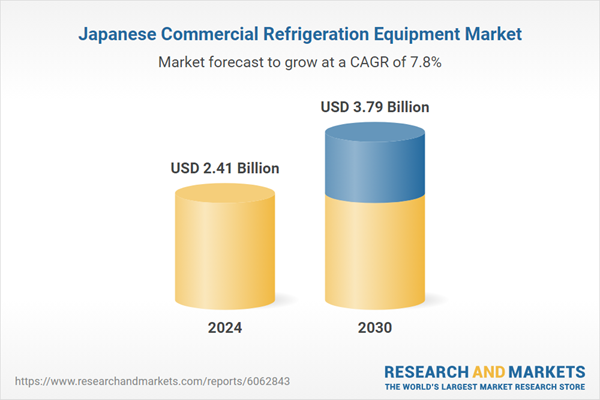Free Webex Call
The Japan Commercial Refrigeration Equipment Market was valued at USD 2.41 Billion in 2024, and is expected to reach USD 3.79 Billion by 2030, rising at a CAGR of 7.80%. The market is expected to witness consistent growth from 2020 to 2030, driven by rising demand across the food retail, hospitality, and pharmaceutical sectors, along with rapid technological advancements and increasingly stringent energy efficiency regulations. Speak directly to the analyst to clarify any post sales queries you may have.
10% Free customizationThis report comes with 10% free customization, enabling you to add data that meets your specific business needs.
Market Drivers
Rising Demand from the Food and Beverage Sector
The expanding food and beverage (F&B) industry in Japan is a primary growth driver for the commercial refrigeration equipment market. With growing consumer demand for fresh, frozen, and processed foods, businesses such as supermarkets, convenience stores, and restaurants are investing in advanced refrigeration systems to ensure food quality and safety while extending shelf life.The surge in popularity of ready-to-eat meals, frozen goods, and chilled beverages has further amplified the need for high-performance refrigerators, freezers, and display units. Moreover, Japan’s vibrant café culture and increasing consumption of specialty beverages, including craft beer and cold brews, are driving demand for dedicated beverage refrigeration solutions. As the foodservice industry continues to grow and consumers seek greater convenience, the F&B sector is expected to remain a key contributor to market expansion.
Market Challenges
High Energy Consumption and Regulatory Pressures
One of the critical challenges facing the market is the high energy consumption associated with commercial refrigeration systems, coupled with stringent environmental regulations. Japan enforces robust energy efficiency standards under the Act on Rationalizing Energy Use, and aligns with international climate commitments, including the Paris Agreement.According to the Japan Refrigeration and Air Conditioning Industry Association (JRAIA), commercial refrigeration accounts for approximately 15% of the total electricity usage in Japan’s food retail sector. Older systems, in particular, are energy-intensive, contributing to high operational costs for businesses.
Moreover, the regulatory push to reduce reliance on high-GWP (Global Warming Potential) refrigerants such as hydrofluorocarbons (HFCs) is prompting a transition to natural refrigerants like CO₂ and ammonia. While these alternatives are environmentally sustainable, the shift involves significant investment in research, development, and technical adaptation - posing challenges for both manufacturers and end-users.
Market Trends
Shift Toward Eco-Friendly Refrigerants and Sustainable Technologies
Sustainability is emerging as a defining trend in Japan’s commercial refrigeration market, influenced by regulatory frameworks and corporate commitments to environmental responsibility. The country is actively phasing out HFC refrigerants due to their high environmental impact and embracing natural refrigerants such as CO₂ (R744), ammonia (R717), and hydrocarbons (R290) that offer lower GWP.A 2022 survey by Fuji Keizai revealed that 65% of Japanese food retailers cited the high initial costs of eco-friendly refrigeration systems as a significant adoption barrier. In response, manufacturers are prioritizing the development of low-energy, environmentally conscious refrigeration units, along with integrated heat recovery solutions that repurpose waste heat for additional operational efficiencies, such as space or water heating. These innovations align with Japan’s broader goal of achieving carbon neutrality by 2050, positioning sustainable refrigeration as a central focus in the market's evolution.
Key Market Players
- Ashford Hospitality Trust Inc.
- Lennox International Inc.
- Altus Group Ltd
- Carrier Global Corp.
- Whirlpool Corp
- Dover Corp
- Daikin Industries Ltd
- Electrolux AB ADR
- Illinois Tool Works Inc
- Johnson Controls International PLC
Report Scope:
In this report, the Japan commercial refrigeration equipment market has been segmented into the following categories, in addition to the industry trends which have also been detailed below:Japan Commercial Refrigeration Equipment Market, By Product:
- Transportation Refrigeration Equipment
- Refrigerators & Freezers
- Beverage Refrigeration
- Display Showcases
- Ice Merchandisers & Ice Vending Equipment
- Other
Japan Commercial Refrigeration Equipment Market, By System Type:
- Self-Contained
- Remotely Operated
Japan Commercial Refrigeration Equipment Market, By Capacity:
- Less than 50 cu. Ft.
- 51 cu. Ft - 100 cu. Ft.
- More than 100 cu. Ft
Japan Commercial Refrigeration Equipment Market, By Region:
- Hokkaido & Tohuku
- Chubu
- Chugoku
- Kyushu
- Rest of Japan
Competitive Landscape
Company Profiles: Detailed analysis of the major companies present in the Japan commercial refrigeration equipment market.Available Customizations:
With the given market data, the publisher offers customizations according to a company's specific needs. The following customization options are available for the report.Company Information
- Detailed analysis and profiling of additional market players (up to five).
This product will be delivered within 1-3 business days.
Table of Contents
1. Introduction
2. Research Methodology
3. Executive Summary
4. Voice of Customer
5. Japan Commercial Refrigeration Equipment Market Outlook
6. Japan Transportation Refrigeration Equipment Market Outlook
7. Japan Refrigerators & Freezers Equipment Market Outlook
8. Japan Beverage Refrigeration Equipment Market Outlook
9. Japan Display Showcases Equipment Market Outlook
10. Japan Ice Merchandisers & Ice Vending Equipment Market Outlook
11. Market Dynamics
12. Market Trends & Developments
13. Porters Five Forces Analysis
16. Competitive Landscape
17. Strategic Recommendations
Companies Mentioned
- Ashford Hospitality Trust Inc.
- Lennox International Inc.
- Altus Group Ltd
- Carrier Global Corp.
- Whirlpool Corp
- Dover Corp
- Daikin Industries Ltd
- Electrolux AB ADR
- Illinois Tool Works Inc
- Johnson Controls International PLC
Table Information
| Report Attribute | Details |
|---|---|
| No. of Pages | 87 |
| Published | April 2025 |
| Forecast Period | 2024 - 2030 |
| Estimated Market Value ( USD | $ 2.41 Billion |
| Forecasted Market Value ( USD | $ 3.79 Billion |
| Compound Annual Growth Rate | 7.8% |
| Regions Covered | Japan |
| No. of Companies Mentioned | 10 |









